
jakedouglas
-
Posts
139 -
Joined
-
Last visited
Content Type
Profiles
Forums
Events
Posts posted by jakedouglas
-
-
Went a few weeks ago. Stayed at La Quinta which was cheap and fine aside from being close to the train tracks. Not that loud but woke me up a couple times. It's at the opposite end of town from Hyalite but I don't think there is much lodging in that direction and it's only an extra 10-15 minutes in any case.
Montana Ale Works and Nova Cafe are great food.
Only saw a couple climbing parties per day during the week but I was told the weekend can be a zoo.
-
Ready to swap me for the Cobras yet?

-
Picking up rock again a bit. Live in North Bend, can clip bolts around here on week days, hit Leavenworth/Index for trad on weekends. Would also like to do a few easy alpine jaunts whenever a healing IT band issue will allow. Also interested in learning aid at some point. Prefer multi-pitch when possible.
Can only lead about 5.7-5.8 by Leavenworth standard but I will try to follow whatever, keen to push my grade. Relatively conservative safety-wise. I have rope and rack.
-
I am keen to hear more about these new multi-pitch routes.
-
Thanks for the additional response. For some reason I didn't see it until now.
I figured it was time to post a followup.
I had annoying tingling in 2 toes and 1 finger that lasted for about a month after the bivy. I was surprised that I received any degree of cold injury in air temperatures that were probably above freezing, but I guess that's what wet boots will do to you.
The sheriffs department was supposed to mail us something detailing the costs of the search and information about how to donate if we wanted to, but I never got it.
ACR was hard to get in touch with and didn't respond until I posted a nasty comment on their public Facebook page, after already using the contact form on their website as well as leaving a voicemail. They sent me a new beacon for free, but have never given me any information about whether my original beacon had a problem. I'm hesitant to trust it and I'm still considering switching to Delorme. At least those units have delivery confirmation of your messages, so you will know whether you are on your own or not.
I guess the takeaway is that beacon owners should test them regularly in the most rigorous way possible and carry them with the knowledge that they just might not work. ACR supposedly makes the most reliable ones but that doesn't mean much to me anymore, and after all, I never saw any data to backup that notion in the first place.
Leaving our itinerary with a family member ended up being very important since the beacon could not locate us with any reasonable accuracy.
-
Hard to say what to expect. Sometimes the snow all gets blown off of some aspects on volcanoes, sometimes it doesn't. I don't have any experience with the standard Adams route in that regard. I would definitely bring snowshoes following the forecasted snowfall. Crampons were not necessary in the conditions we experienced, but they certainly could be if it were more firm and icy.
Probably best to bring both and be prepared for a variety of conditions. Avalanche hazard is a concern as well.
-
As of 5/9, not too terrible conditions on the summit slope, great corn from the false summit downward.
-
Interesting that you had good Verizon service on top of Dragontail. There is none over on Colchuck.
I think someone could make a killing by sitting at the gate selling microspikes.
-
-
Can't argue with any of that.
I'm pretty burnt out on talking about this so I'm going to let it end here for now.
I've contacted the beacon manufacturer and I'll be sure to report whatever I hear back.
Thanks for the discussion everyone.
-
Lake to summit is 3100 feet.
I track gain per hour or some derivation thereof on every trip I do, climbing, skiing, etc. In this context, assuming that we would climb the face at the same rate we climbed the couloir was a big mistake. Here are some fairly accurate breakdowns from the times as best as I could reconstruct them from GPS records and photo timestamps:
- Toilet to bottom of NBC: 1000 feet / 1.4 hours = 714 feet/hr
- 45 minutes to put on crampons, harness, brew, snack, rack up
- Bottom of NBC to top of NBC: 1400 feet / 5.75 hours = 243 feet/hr
- Top of NBC to summit block: 700 feet / 5.5 hours = 127 feet/hr
Climbing the face at the same gain per hour as we climbed the couloir would have put us at the summit block around 5:00pm instead of 7:30pm, but you can see that it was nearly twice as slow. We started pitching it out, and while the couloir goes mostly straight up, we probably did almost 3 ropelengths of traversing on the face. We failed to account for this in our research and discussion and it made a big difference. Obviously pitching it out was the biggest slowdown.
These numbers are still a big joke and nowhere near acceptable but maybe you can see how we thought we had a solid chance of making it when we decided to go for it at the top of the couloir instead of bailing.
- Toilet to bottom of NBC: 1000 feet / 1.4 hours = 714 feet/hr
-
Maybe dial it back a bit and get more comfortable on easier terrain.
Yup.
-
Quick thoughts:
1. Turn around times in winter can be a bitch when you don't get the objective, but helpful in avoiding man bivy.
2. Weight on your back. Looks like the NBC is a bit lean, but 10 cams and 3 pickets for a snow climb is...extra weight.
3. Fitness/nutrition. Speed is safety for sure.
I think you guys did well, but with room for improvement. No shame in posting this TR in that is had lead to a thoughtful, and fairly civil (rare for cc.com), discussion.
One question, you guys drank 3L by the time you got to the base of the couloir? Or are you saying you left camp with 2L and brewed up another liter or two at the base? Either way, that seems like a lot of hydration for like 500 vf.
We carried 1 picket. The rock gear is heavy but it substantially sped our progress on the face, providing plenty of options for placements. That we wanted so many placements is the larger issue...
We left camp with 2L each and brewed another liter or two at the base. We had probably only drunk a few sips on the way up to that point but figured we should chug a bunch to stay ahead of it since it was the last convenient stopping point for a while. The place we did this at the bottom of the NBC appears to be 1k feet above the lake. It had been 2-3 hours since breakfast where we'd had coffee (dehydrating) so I don't think this is unreasonable. Sometimes I drink a liter of water by lunch time sitting at my desk.
People are fixating on the food and water thing more than it deserves IMO. We ended up running out but it's because we misjudged the route, not misjudged the amount of food and water based on what we thought the route would be. The fact is that we're wimps about climbing without protection (particularly myself) and that's probably where 75% of the time went. This isn't the first time we've done long days of exertion and when we were actually moving our pace was fine. We both train a good amount and we've both climbed with experienced partners, who as far as I know never found our pace to be inadequate as long as we were roped and they were doing the leading.
-
We left camp with 2L each and brewed another 1-2L at the bottom of the couloir while we racked up to replace what we had drunk on the approach, and chugged more on the spot. We also drank electrolyte mix in the water all day.
I don't believe that we were particularly naive for leaving camp with a belly full of breakfast, 2L and 2,000-2,500 calories each, and a 4oz fuel canister for a climb largely on a shaded northern aspect that was supposed to conclude by mid-afternoon. On the contrary, we've been chuckled at numerous times for carrying lots of food and a stove on day trips in the past.
Nutrition and hydration are very important and I agree that many/most people skimp to the point of being a detriment, but I promise that we could have been getting extra-large pizzas and fresh squeezed orange juice delivered and we still would have botched the climb.
While I'll carry more food and fuel from now on in addition to other contingency items, I'm probably not going to carry 5,000 calories for a one day climb. Some of the eating and drinking is supposed to take place once you're back at the tent. Developing the judgement and awareness to pick appropriate objectives and bail when they turn out to be a mistake is the larger, more holistic issue.
Glad you made it out and I hope you're feeling better.
-
Echo what others have said, glad you made it ok. That's always the most important thing!
As to the style points, you guys already know it was a bummer to hit the button. You did a good introspective post-mortem in this write up, good for you for being so publically self-critical. Nothing to add there except,
The NBC on Colchuck is almost the easiest alpine route there is, or at least perhaps the easiest "full length" alpine trip, one I always recommend to all newbies looking for their first "real" alpine snow climb. But that assumes a few things: level of fitness and energy, and a certain element of preparedness, and being pretty good and fast at snow-climbing. Bottom line, one shouldn't be spending 12 hours round trip to camp, let alone to the summit. There just aren't that many hours in the day, in March. I am not sure where the hours went....it sounds like you guys already know all that, and *started* with completely the right mindframe, simul-soloing the first bit, foregoing the rope, all that was really good, but it seems to have spiraled down with some effort and fatigue, compounding into you not making it to the summit by dark. The walk down to Colchuck Col and back to your tent would have been tiring, but not very dangerous even at night (...* keep your crampons on!!). I would look very carefully at your energy replenishment scheme, actually count the calories you ingested Fri night: it sounds like neither of you probably ate or drank enough from the day before to be fully recovered for the climb, the day of. You needed thousands of calories Friday night, did you get them? Whatever you brought and ate, double it for next time. I am a chronic under-packer when it comes to food, so I know this first-hand from all-too-often bonking after under-eating/under-hydrating.
Thanks for the remarks. Being the easiest thing that could still be considered a route is why I picked the NBC. Gerrit has more snow climbing experience and I think I slowed us down by wanting to use the rope in places that he would have been OK without. I doubt that either of us would have climbed the face without the rope but in retrospect we would have been fine soloing the rest of the couloir above the steps near the bottom.
Not to excuse the mistake, but I'm curious how much the snow conditions contributed to our slow time. On Friday night the party whose tracks we followed arrived back at the lake around 7pm and walked past our tent. They were surprised at how long it had taken and said that they had started from camp at 9am and soloed the entire route except for a single roped pitch. This would make it roughly 10 hours round trip which seems to border on unacceptable in your opinion.
On the approach we had talked about bailing if it ended up being a wallow fest, but once we started climbing we failed to recognize that it was a problem and adjust the plan. We have plenty of history bailing on things when the situation didn't seem right, so I don't think we were being hard headed. I think we just continually underestimated how much climbing we had ahead of us.
I ate around 2000 calories after arriving at the lake Friday afternoon and 500 calories for breakfast on Saturday morning. I do a lot of endurance exercise and I feel like I have a very clear connection with my body regarding energy and rest needs. The effort expended to get to the lake was not significantly taxing to me and I felt good on the morning of the climb and throughout the vast majority of the day.
Gerrit was more tired to begin with and could have eaten more on Friday night, but he did not move that much slower than I did during the climb. I carried the rope and rack on approach so he could conserve energy. I would say that his tiredness was a contributing factor but not a huge one until later in the night. All things considered, he did a good job leading the face and getting us to the summit block.
Yes, the bottom line is that we took way too long for a variety of reasons. It's clear that we should have bailed early on.
-
After you guys set the beacon off did you leave it in one place without moving it?
Yes, for the most part. I think we held it in our laps for a few minutes and then set it down on top of hard packed snow, or I may have set it on the lid of the stove when we were not using it, thinking that the cold would not be ideal for it. The specified lowest operating temperature is -4F though and it was nowhere near that so I was not too concerned.
It remained there blinking for around 3 hours until we started packing up to depart. The antenna was oriented in the correct position. We were sitting with our backs against the wall of the summit block but the beacon still had a clear view of at least half the sky.
My iPhone had been in airplane mode (GPS disabled) to save battery, as I always do when climbing in case it should be needed for emergency. I pulled it out to look at our location on a topo using the Gaia GPS app and it located us with very high accuracy within only about 15 seconds. I took a screenshot at the time to reference later:
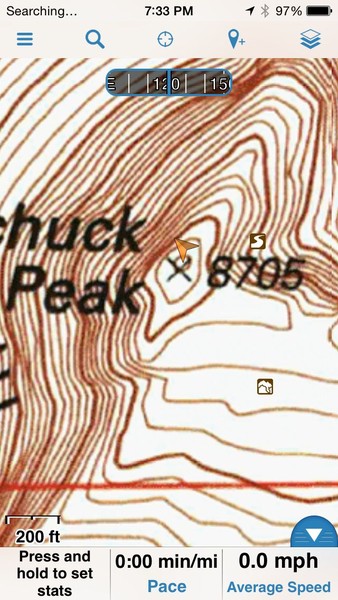
When we packed up to leave we left the beacon on but put it in the lid of Gerrit's backpack. Once we were on the summit and saw the helicopter we disabled it.
Putting it in the backpack and climbing with it could have generated bogus locations. Like I said previously though, my understanding is that the nearest reported location to our actual location that was ever received by SAR was at Witches Tower and some were as far away as Prusik Peak. I heard all of this through my wife and it sounds like there was a lot of confusing information being passed around so I'm going to follow up and clarify.
In any case, this is supposed to be one of the most rugged and reliable beacons on the market. With the high accuracy provided by GPS in common consumer electronics such as phones and sport watches I find it hard to believe that a subtle operating error should cause this beacon to fail to locate us within a mile of our location with open sky and clear weather.
-
The sheriff did mention to my wife that it was highly unusual to see such widely scattered locations. I will post in detail eventually when I get more information about the beacon issue.
-
I don't know about you, but all it takes is reaching the car before all struggles of an epic disappear out of my head and I'm already planning for something else.
This is a lot of why I felt I had to write a TR. The whole trip already felt like a dream by the next day and I had to look at the photos I took to really believe it happened. It would have been easy to avoid the subject and pretend like it never happened, but it was probably the worst night of my life and I would like this to stick around as a reminder to myself.
-
Ouch, that's what I'm using. Do you think the battery might have been low? How old was it?
I believe I purchased it 2-3 years ago. The battery expiration date is 07/2018. I have only run the GPS self test 3-4 times and it is supposed to have enough excess battery life to run it many more times than that.
-
It was an ACR ResQLink 375, a true PLB so to speak. I bought it over SPOT or similar for its reliable reputation and I was very surprised when I heard that it had reported bogus locations. We had not even considered that as a possibility with the open sky, clear weather, and leaving it active for many hours. I ran the self test a few weeks back and it seemed to say that everything was fine.
-
Trip: Colchuck Peak - North Buttress Couloir, unplanned bivy
Date: 3/7/2015
Trip Report:
On Friday afternoon I left the gate at 12:30pm to meet GerritD at the lake to try the NBC the following morning. I hit the lake at 3:30pm and found Gerrit resting in his tent, having just returned from a day of climbing by himself around the lower north buttress area. We ate dinner and waited up for another CCer who was supposed to meet us. Around 9pm he still hadn't showed so we headed to bed.
We woke at 4am and had a fairly slow start that included chipping ice off of the toilet until the lid would open. Approach conditions were slow, with frustrating post holing through deep soft snow. We took a break to put on our gear and were climbing up the couloir at around 8am.
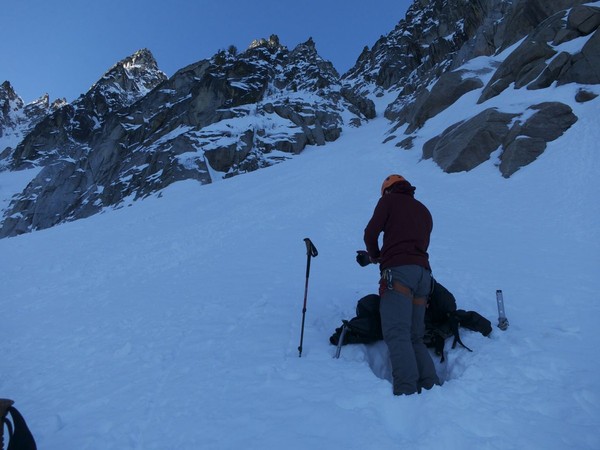
Getting ready at the bottom of the couloir. The first short ice step is visible at the choke.
We climbed the first ~250 feet unroped including a short ice step. We arrived at 2 more steps, the top of which looked steeper, so we pulled out the rope and I led a short belayed pitch. I was glad to have the rope on the steeper top step as it mostly crusty snow that did not feel very secure. Things looked easier from here and Gerrit led off with the agreement that we would simulclimb after he got a piece or two in.
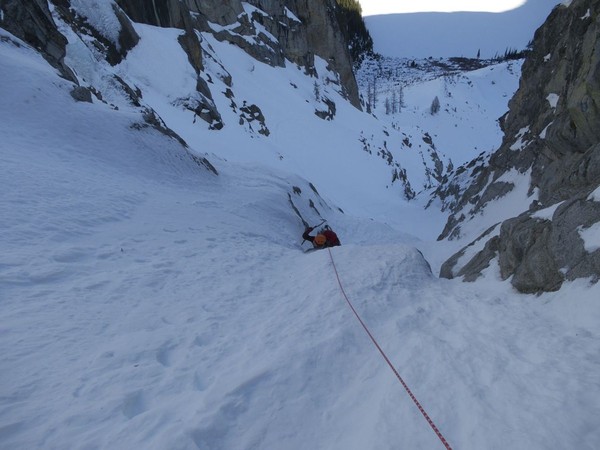
Gerrit following the steps
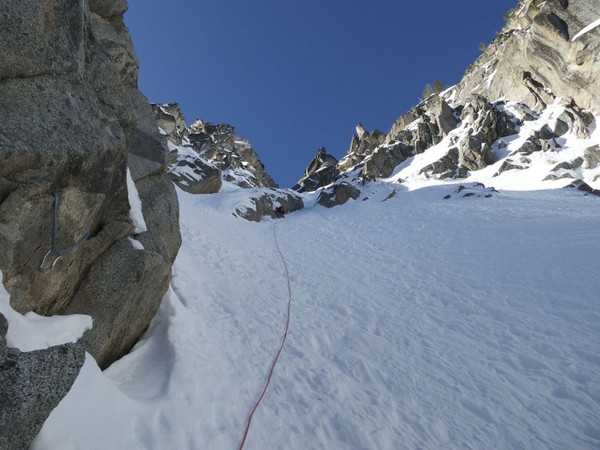
Easier terrain above
Unfortunately we got too attached to mental comfort of the rope and protection even though the climbing was easy and mostly secure. We kept building anchors to rerack and avoid getting low on gear, causing our simul blocks to come up short, maybe 2 ropelengths at a time. The snow was deep, slowing us down even more. We had counted on following the boot pack of a party from the previous day for increased efficiency, but it had long since filled in with spindrift and was no better than breaking our own trail.
We finally hit the top of the couloir at 2pm. We had discussed the feasibility of bailing and agreed that it would be very time consuming by this point with only one 60m rope and myself having less than ideal confidence to downclimb at a decent pace. We had 700 vertical feet to go which seemed very reasonable with 4-5 hours of daylight left, and we were still feeling fine, so we rounded the corner out onto the NW face.

Looking back down from the top of the NBC.
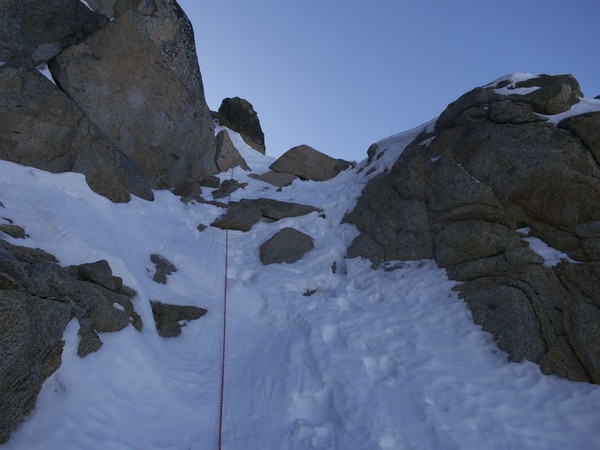
Rounding the corner onto the face
The face turned out to be quite a bit different than the couloir though and a lot more involved than the vertical gain led us to believe. Exposed, more sugary snow, often scraping on rock underneath, and lots of traversing. There must have been as much traversing as there was vertical gain and this threw off our time estimate substantially. We got nervous and started pitching it out, reasoning that as long as we stayed safe we would certainly get up and over by nightfall and could walk down in the dark. The terrain was more complicated than the couloir and we were glad to have the old boot tracks to follow. I had read that we should continue trending right and the tracks agreed.
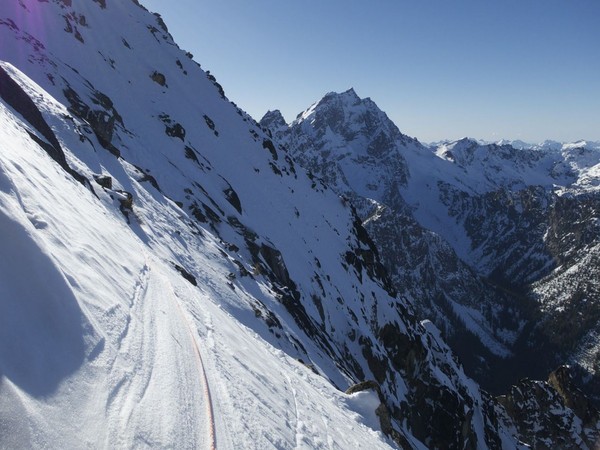
The exposed NW face
The sun started going down. Gerrit has more alpine climbing experience and I had been forfeiting some of my food and water to keep him fueled and leading as quickly as possible. His headlamp had died on the approach and now we pulled out the spare battery to find that it looked exactly the same but was a few millimeters too short - the wrong battery. I gave him my headlamp and would follow the last 2 pitches in the dark, building a mental model of how to break down the anchor before he led out each time.
We finally arrived at the base of what had to be the summit block around 8pm, feeling pretty fried. The boot tracks ended at a point where the rock was ledgy but also kind of steep and exposed and it wasn't clear whether there were any protection opportunities. I would have walked right up it had I been wearing even running shoes and had some energy, but mantling in crampons in our depleted state seemed like a bad idea at the time. From researching the route I was pretty sure that there was an easier way but we couldn't tell what was what by headlamp. We resolved to take a break and collect ourselves.
The break turned into a bivy as we lost the confidence to continue in the dark. The moon had been very bright the night before so we hoped that it would soon rise and illuminate the way. We put on all of our clothes, sat on our packs, took off crampons and put our feet on the rope. I had an ultralight emergency bivy sack that I've thought was stupid every time I've thrown it in my pack in the last 3 years but I was glad to have it now. We couldn't pull it up past our hips but we could fit both of our legs into it and this helped to break the slight breeze and share some heat. We quickly tore it by punching a boot out of the bottom, reducing its effectiveness.
We had brought the stove and one small fuel canister but quickly found out that there wasn't much left in it. We managed to make about one liter before it started to sputter and we decided to save the rest for later. Gerrit had a warmer parka so I got to keep the warm bottle in my jacket.
For the first couple of hours I actually managed to sleep for periods of a few minutes at a time and it wasn't too bad. The last time we had eaten was around 5pm though and our only remaining food was one Snickers bar that we wanted to save for our push out of there. Without any calories coming in, we started to get cold in a bad way. My boots and socks were soaked and so were his gloves. Every time a breeze picked up we were reduced to convulsions. We took turns doing 10 minute sessions of squats before getting back into the bivy sack. This would generate a miniscule amount of heat that would always dissipate faster than it took to create. We used the last of our fuel to rewarm the last of our water and I stuffed the bottle back down my shirt after some sips. Then we got "close".
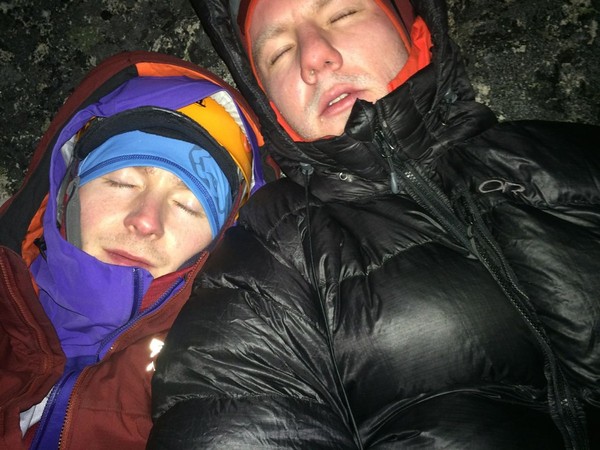
Getting cozy
Early on Gerrit had brought up using the emergency locator beacon that I always carry climbing and skiing. I was strongly opposed to the idea on the grounds that we had not exhausted our options. The beacon is clearly for use in situations of "grave and imminent danger" and as shitty and serious as our situation was, it did not yet fit the criteria in my eyes. Could we really have climbed 99% of the route but not be able to get up the last short pitch and descend?
The moon came up but never shined enough on our aspect to show us the way, so we kept on waiting for sunrise. Mt. Stuart was lit up in the moonlight and looked like the most inhospitable place on earth. I thought of the nature of the climbing over there and how I would probably never be worthy enough to consider it. Did I even want to? I had just gotten stuck pushing my limit on a route that is a steep ski for many people.
Gerrit continued to bring up the beacon. I talked about how we would have to leave all of our gear on the mountain, how everyone at home would be worried, how it could potentially divert rescue resources away from a more serious emergency. He said we were too fucked up to keep climbing safely. What if the leader climbed themselves off route and couldn't downclimb? What if one of us slipped and broke an ankle? What if it got colder? Could we afford to wait until the sun came up? Couldn't we just be digging ourselves into a worse situation?
Doubts had grown in my head as the night went on. The cold was messing with me and I started to wonder how cold a person can get before they can't come back easily. I had never been this cold before and the things we had been doing all night to stay warm weren't working anymore. Earlier I had been sure that I had more in the tank to get us out of there but now I was questioning myself. I still felt like we had an obligation to try.
Eventually Gerrit insisted that he would be unable to descend safely under his own power even if I could take us up to the summit. I told him that we should split the Snickers bar and he should reconsider after having some food. He stuck to his opinion and around 4:30am I handed him the beacon and said that he would have to do it himself. I felt ashamed and embarrassed. I felt terrible about the call my wife was about to get. We speculated about what would happen and how long it would take to sort out the aftermath. I closed my eyes and tried to forget where I was.
At around 7am I was too cold to sit any longer and it was getting light. I got up and walked over to where the old boot tracks had stopped at the base of the rock but still found it unappealing like the night before. On the other side of our bivy site was a short snow ramp and some easy looking ledges and in the morning light it looked like they had to lead to the top. I got all of my stuff back on, went on belay, and scrambled some of the easiest 30 feet of the whole route to the summit and into the morning sun. I brought Gerrit up and we started our descent.
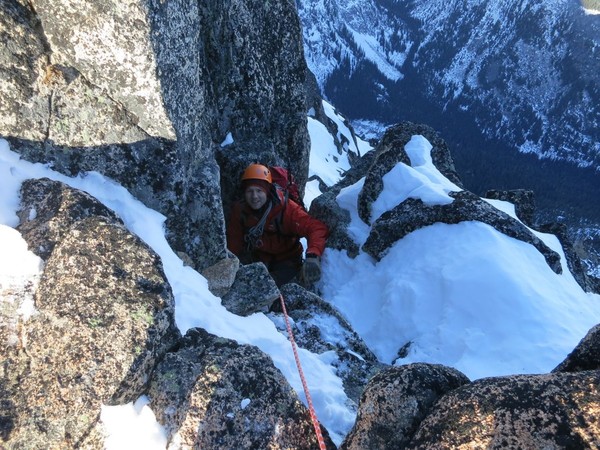
Gerrit scrambling to the summit
As we walked across the summit plateau the helicopter arrived for the first time. We weren't sure what to do. Wave like "hi"? Wave like "go away"? Thumbs up? We did some of each and they seemed to pause near us but did not communicate back. They flew off towards Dragontail which confused us, but we just kept descending. My brain was now boiling in the sun on a southern aspect and I was messed up enough that I didn't trust myself to downclimb the steepest parts of the snow off of the plateau, so I did 2 rappels on the way to Colchuck col. We passed several parties on their way up that were very generous with food and water that we needed badly. Thank you!
The helicopter continued to fly back and forth out of sight as we walked down the glacier. Eventually they started circling us and made contact with hand signals. They landed on the lake and we confirmed that we were the group in question and that we were fine.
I later learned that the beacon had been reporting locations all over the Stuart range and the closest one to our location was near Witches Tower, probably over a mile away. My understanding is that the sheriff probably located our bivy site and us only because they made contact with my wife who I had told our intended route. I used GPS on my phone to look at a topo while we were at the bivy site and it had no trouble, so I imagine that the beacon must have been defective. I intend to follow up with the sherrif and beacon manufacturer about this issue. Notably there was no cell phone service with either ATT or Verizon on on the summit of Colchuck.
A couple days later I think I still have more questions than answers about the experience. I consider myself to be very conservative about what I get myself into, almost to a fault. I had been researching the route on and off for over a year and thought that it would be a good challenge for us without being risky. Did I wildly misjudge the appropriateness of the route for our skill level or did we just make one too many mistakes that added up to a big mess? None of the climbing was difficult. When should we have bailed? Our pace was slow, but groups top out in the evening all the time. After all, it was only a few hours difference between a long day and an overnight epic. How would we have figured out beforehand that the face would take so long? Should we have pressed on in the night? When your head is in a bad place, how do you know whether having found yourself up shit creek is part of the experience that you came here for or if things have really gotten out of hand and you need help?
I do have some thoughts on emergency equipment and the survivability of different conditions. We had the most mild weather that a person could ask for with minimal wind and temps probably in the low to mid 30s. But with tired bodies, no food, and wet clothes, I feel like we were walking a thin line. If conditions had deteriorated much at all, the situation could have been grave. Luckily I kept putting back on my wet gloves all day while climbing and preserved a dry pair for the bivy. We used basically every item in our packs and it was barely enough. We talked at length during the night about things that would have made it infinitely better and we would have paid a million bucks for in the moment: a short sleeping pad to sit on, a bigger belay jacket, puffy pants, a more substantial bivy sack that could provide full coverage and fit 2 people, more fuel, more food, a change of socks, a tarp, etc. I'll definitely be adding or upgrading an item or two in my pack and adjusting the way that I pick clothing appropriate for the weather forecast to have a larger margin of safety.
This was somewhat embarrassing for me to write and post but I hope that myself and others might learn something from it. Climbing is more popular than ever especially at the novice level and I find it hard to imagine that situations like these do not occur with some regularity, but they are rarely written about here.
Gear Notes:
10 cams to #2, 1 set of nuts, 1 picket, 3 pins. Should have brought all double length runners.
Approach Notes:
Icy trail, post holing beyond the lake.
-
If you are talking about this coming weekend, GerritD will be camped out at Colchuck Lake in an orange MSR tent looking for partners. I will probably be joining him for Saturday but maybe you two could climb something together too.
-
Sketchy Dan alert.
-
I believe it is still gated at the Eldorado TH.

Dynafit binding failures
in Climber's Board
Posted
Dan, not to diminish how lame the problem is for those that have had it happen, but we have 4 pairs of Speed Radicals and I have found them very reliable. Based on my experience I would probably not stress this so much as to regret your purchase.